| Author |
 Topic Topic  |
|
|
|
enewton
Gold Member
   
 England England
549 Posts |
 Posted - 08 May 2005 : 12:16:31 PM Posted - 08 May 2005 : 12:16:31 PM




|
Hi, (sorry this is so long, but all details needed to get the right advise)Vets dont know that much about why it happens, so I thought you guys as arab owners would be a help.
If anyone has any experience with tying up!
I would presume the bigger showing studs have some experience with this??
My Mare Koko, got Azoturia on Thursday night!!
I have so much experience in Arab's/horses having worked on studs etc, but I have never seen this happen before, it was really frightening, now Im scared stiff (no pun intended) incase it happens again!!
She has never had this before, shes been in work since before christmas, but only fittened up for ridden show condition over the last 4 months, she works for about 30/40 minutes ridden 5/6 days a week, has adlib good hay, and is fed on, 1 scoop of Hifi light and 1 scoop of Sacracen improver mix, she gets this 2x a day, she goes out into a yard for a wonder around before her work, and is turned out every weekend for 3/4 hours sat/sun to graze good grass, I recently changed her routine, because she was going out in the week all day while I was at work, but Ive had to change this, because my gelding, was loosing condition as he dosnt want to stay out after 3 hours, and was running the fence..
She had worked as normal Wednesday night...Thursday night rode her for 20mins, not hard, as she is quite fit now, rode her round in a flat 5ish acre paddock, walked 1 full lap, to warm up, trotted 1 lap, canter 1 long side only, walked a few steps, trotted back up the long side, cantered 2 20metre circles on both reins, and finished, walked her back across the field, and took her to the stable, not sweating, not blowing, as she is quite fit, this was easy work for her, last weekend, my Husband rode her hard work and she was fine after......turned her loose in the stable yard to wonder around while I did her bed, in less than 10 minutes, I realised, she wasnt moving, she was stuck still ridged in her backend, pivoting round with her front end, I knew what was wrong and called the vet, she was so cramped up, the vet took over an hour to come, and she still had not moved, obviously I didnt try and move her, because I quickly grabbed vet notes for horse owners book, and did what it said, I knew from this she wasnt having a really acute attack of it, as she wasnt showing colic type symtoms and not sweating, and no muscle tremors.
She had some injections to sort her out and finally after 2 hours stuck to the same spot, we got her the 12ft to her stable, only after my husband had to poke her in the hamstring to get her to move, through all of this she still looked happy, no face pulling or anything...
Next morning, walking round her box fine, she had to stay in,vets orders then walked round the yard the next day, and now shes out in the paddock, all looking so normal again, it happened so fast, it was quite unreal!
Lack in Selenuim can contribute, so shes on that, and bought her a selenuim lick as well, only trouble is Im now paranoid it will happen again, she so well trained inhand, sometimes she plants her back end, as if shes waiting for me to position her front legs, and now I think, god is she tying up, or just trying to stand up!!LOL
She is 5 years old,just this week, she is not fat, but well covered as she doing ridden showing, Ive got a show next weekend, then wales & west weekend after, so I will be hopefully working her as normal from prob' Tuesday this week.
The only change in routine is the not going out in the field in the week, although she gets to wonder round a yard, and pick at a haynet, for half an hour after work, before or after her work.
My horses will be moving from my mother in laws (next door) to our property at the end of May, as our new stables and yard will be finished then, so she will go out in the week again, as I can then leave the yard gate open, if my gelding wants to come, he can get him self in!!!
Does anyone, know, if this happens, once, will it happen regulaly, what else can I do to prevent it, I will spend even more time warming her up and cooling her down...????
My vet will be doing an excersize test with her if it happens again, taking blood after had work, to see what her Enzymes (spelling) levels are like!!
|
Emma Newton
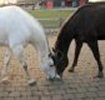 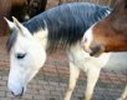 
|
|
Report to moderator
|
|
|
CeliaS
Gold Member
   

Wales
646 Posts |
 Posted - 08 May 2005 : 1:43:03 PM Posted - 08 May 2005 : 1:43:03 PM




|
Hi Emma
Do take a look at the archives on The Panel section. Go to all forums then click on the A in the right hand column. This brings up the archives and there is a thread on tying up. I think it is on page 2 of the archives.
My friend's horse used to tie up and she recommended high fibre, low protein diet. exclude alfalfa but hi fi lite is ok. Also use electrolytes - Dodson and Horrell Surelyte is a good balanced one. She also kept her horse away from clover.
HTH
best wishes
Celia |
Celia
    
http://www.egbdecymru.co.uk
http://www.artantix.co.uk |
Report to Moderator  |
|
|
CeliaS
Gold Member
   

Wales
646 Posts |
|
|
enewton
Gold Member
   

England
549 Posts |
 Posted - 08 May 2005 : 2:16:48 PM Posted - 08 May 2005 : 2:16:48 PM




|
Thanks Celia, Im cutting her mix to a hand full with Hifi lite, and going to try her on pony nuts, just hope she stays in show condition, (she is a good doer) will add some oil, and she has selenium powder in feed and a lick, I got her yesterday, its difficult to put her out in the week for long, but all that will change at the end of this month, when they move to my house..
My husbands an equine therapist, so Ive just asked him to massage her this week...will speak to my vet this week to take some bloods. |
Emma Newton
  
|
Report to Moderator  |
|
|
CeliaS
Gold Member
   

Wales
646 Posts |
 Posted - 08 May 2005 : 2:30:39 PM Posted - 08 May 2005 : 2:30:39 PM




|
Hi Emma
I hope all goes well.
My arab is such a good doer I have had to cut out all his haylage and he is now on a tub of hi fi lite as a hay replacer and happy hoof/speedibeet with dengie optimum as his bucket feed. He was bright as a button riding out this morning.
Let me know how you get on.
Celia |
Celia
    
http://www.egbdecymru.co.uk
http://www.artantix.co.uk |
Report to Moderator  |
|
|
Sabaska
New Member
England
6 Posts |
 Posted - 08 May 2005 : 5:55:24 PM Posted - 08 May 2005 : 5:55:24 PM




|
Hi Emma
I have worked as a nutritionist for a feed company for many years, so I hope I can offer some words of advise. There are many factors that are believed to contribute to the occurance of rhabdomyolysis and these include:
> Not reducing the concentrate ration when the horse is rested.
> Feeding concentrates that are high in soluble carbohydrates.
> Electrolyte losses.
> Unbalanced diet.
> Hormonal influences.
> Not warming up and cooling the horse down.
One thing I would recommend for your mare is that you change from a coarse mix to cubes. This will help to avoid excessive levels of soluble carbohydrates. It is also important to use electrolytes if the mare is sweating excessively during work. There is no need to feed these on a regular basis if she is not sweating as the horse does not store electrolytes and will excrete them if not required.
Also be very careful with the levels of vitamin E and selenium you feed. If the horses intake of many vitamins, minerals and protein exceeds their requirements they excrete what they do not need. However, with Vitamin E and selenium this is not the case.
If you would like any further information please do not hesitate to contact me.
Regards
Linda font=Arial][/font=Arial] |
Report to Moderator  |
|
|
t_linington
Gold Member
   

United Kingdom
815 Posts |
 Posted - 08 May 2005 : 7:59:45 PM Posted - 08 May 2005 : 7:59:45 PM




|
| Blimey Em....have only just read this, hope Koko is ok...will ring you in a bit. XX |
tina linington
SIG REMOVED - PLEASE ENSURE SIGNATURE PICTURES DO NOT EXCEED 95 PIXELS IN HEIGHT SIG REMOVED - PLEASE ENSURE SIGNATURE PICTURES DO NOT EXCEED 95 PIXELS IN HEIGHT |
Report to Moderator  |
|
|
white bryony
Gold Member
   

United Kingdom
778 Posts |
 Posted - 08 May 2005 : 8:18:50 PM Posted - 08 May 2005 : 8:18:50 PM




|
I would recomend keeping her warm with a blanket after she is ridden, her muscles will cool down and this could cause her to tie up, maybe you could leave her loose in the yard for a little while once you have untacked her.
Unfortianatley my pony suffered from this and we found doing this helped, she very rarely gets this now,
is your mare easily excited when ridden? this could be a possible cause of her tyeing up. |
Emma
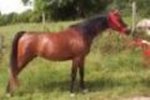   Salsifis Salsifis |
Report to Moderator  |
|
|
enewton
Gold Member
   

England
549 Posts |
 Posted - 08 May 2005 : 9:41:08 PM Posted - 08 May 2005 : 9:41:08 PM




|
Thanks, I did put her loose in the yard last Thursday night, I always do, I didnt put a blanket on her tho', I never thought I need to as it has never happened before, it wasnt cold that night, but I will be from now on!!
I will be getting back on her this Tuesday night, just a very long walk tho'
She is very calm to ride, she isnt fizzy at all, forward going but very sensible... |
Emma Newton
  
|
Report to Moderator  |
|
|
diane
Bronze Member
 

United Kingdom
177 Posts |
 Posted - 08 May 2005 : 11:11:23 PM Posted - 08 May 2005 : 11:11:23 PM






|
Hi Emma,
You say you are going to ride her Tuesday. I would not attempt to until you have the result of the blood tests. You have to make sure the AST and CPK are down to their correct levels, otherwise it will cause further muscle damage. You will be able to tell primarily if the urine is a reddish colour. Please wait for these results as I personally have had previous experience with one horse. Also be very careful with Selenium as it is toxic if fed in excess.
Do not feed oil at the same time as this depletes it.
There are many things including stress, that can enduce tying up, and I would always always try and put your horse out before and after riding for at least an hour, to keep his digestive system and muscles working. Also a high fibre diet with no cereals until you have iliminated the cause. Hope this helps. Diane |
http://www.lapwortharabians.com |
Report to Moderator  |
|
|
Valentine Arabians
Gold Member
   
United Kingdom
586 Posts |
 Posted - 09 May 2005 : 05:35:44 AM Posted - 09 May 2005 : 05:35:44 AM




|
Hi Emma,
Our foundation mare suffers from Azoturia. We changed her diet to rolled oats, D&H Suregrow (400gms per day - which all our horses are on, in any event) and Hi Fi Lite. We also give her 3 scoops of NAF Vitamin E, Lysine and Selenium per day. She also has one level scoop of Feel Good 30 - Electrolytes in her stable water bucket.
Since starting her on the NAF product and adding the electrolytes to her water, I am back on board riding her and 'touch wood' we have not seen one tying up session since.
Good luck.
Liz |
Liz & Walter Downes
www.ValentineArabians.com
Lincolnshire |
Report to Moderator  |
|
|
sazzlepants71
Platinum Member
    

United Kingdom
3536 Posts |
 Posted - 09 May 2005 : 1:32:13 PM Posted - 09 May 2005 : 1:32:13 PM




|
 Hi emma , i have just come online and seen this oh my god!! you poor thing its so scary when they do that too you Hi emma , i have just come online and seen this oh my god!! you poor thing its so scary when they do that too you
Panache had this a couple of years ago and i have too keep him on high fibre ( cubes ) v.low sugar / protein levels ..diet ,
In the winter i add the 'speedi-beet' quick soaking sugar beet for condition levels he also has dodson and horrel sure-grow
( excellent feed )
also good to add is a 
MSM - Based product for mobility , warming up ( take twice as long )
before 'real' work
and cooling down is vitally important, try and work every day lunging is good !
his last attack was 5 years ago , so it can be managed and he shown/competed successfully , so dont panic sweetie
do add electrolytes in water before travelling during competing..
horses get really dehydrated more than we realise , if she's fussy do the sugar beet water trick to tempt her ..
Regular work and fitness and keeping constant eye on their 'form ' and diet can do the trick keep us updated how she is improving...[;)
also very important , turn out as much as possible to prevent stifness in the muscles , lack of mobility and movement and then 'sudden' exercise is a big contributory factor of repeat attack

all the best sazzle , panache and ramak big kiss to koko xxx]
|
  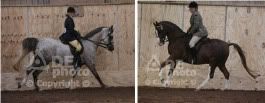 |
Report to Moderator  |
|
|
enewton
Gold Member
   

England
549 Posts |
 Posted - 11 May 2005 : 09:53:49 AM Posted - 11 May 2005 : 09:53:49 AM




|
Thank you, for everyones advise, I now feel much more up to speed
on preventing this happening again to my mare.
I did actually ride her last night, for 20 minutes of walk, and she was fine, I had spent a while massaging her before and after riding, kept a fleece over her quarters before and after excersize, will do a bit more with her tonight and so on.......
|
Emma Newton
  
|
Report to Moderator  |
|
|
Libby Frost
Platinum Member
    

United Kingdom
4711 Posts |
 Posted - 11 May 2005 : 10:21:50 AM Posted - 11 May 2005 : 10:21:50 AM




|
| When you ride do everything gradually/ what i mean is when you warm up walk for an extra amount of time trot the same, when you canter, after,instead of going straight back to walk ,trot for a bit first,then go back to walk and walk for a bit before halting.My sister's mare used to tie up and this is what she used to do whilst riding to try and prevent it,good luck! |
 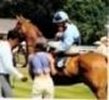    |
Report to Moderator  |
|
|
bertie
Silver Member
  

252 Posts |
 Posted - 11 May 2005 : 10:55:39 AM Posted - 11 May 2005 : 10:55:39 AM




|
The condition Equine Polysaccharide Storage Myopathy (EPSM)has been found in Arabian horses too (always best to consider all possiblilties!!)
Tying Up
The exact causes of tying up (known in draft horses as "Monday morning disease") have yet to be determined, and horses do tie up for reasons unrelated to EPSM. To date, however, examination of muscle biopsies from horses that have tied up, and of diet change in affected horses, indicate that EPSM may be a more common cause of tying up than was previously thought. We have not yet seen a muscle biopsy from a horse that was brought to us for difficult-to-treat tying up that did not show evidence of EPSM.
Any horse that ties up—even if it occurs while an unconditioned horse is being conditioned—should be suspected of having an underlying metabolic problem. EPSM horses may also have decreased blood levels of selenium, but these horses still can have problems, even when selenium levels are corrected. Some EPSM horses have had persistently low selenium levels, even when supplemented at high levels or being given injections. This is not surprising, as selenium needs are greatly increased with exercise or any muscular damage. Selenium levels generally return to normal following diet change for EPSM.
Check out http://www.ruralheritage.com/vet_clinic/epsm.htm for more information.
Good luck!!
|
tara x
~
The only things guaranteed in life with driving Teamsters is Taxes, Death & Runaways!!
   
(Pastal by Nicci Hamilton)
|
Report to Moderator  |
|
|
JMRT
Gold Member
   

England
562 Posts |
 Posted - 13 May 2005 : 3:09:36 PM Posted - 13 May 2005 : 3:09:36 PM





|
Hi Emma
My boy had an acute attack of Azoturia for no reason. Never had it before & will probably never have it again. He couldn't be ridden for over 3 months after due to the CPK damage. Although he looked fine it in the blood & muscle damage is hidden. He was being correctly fed, warmed up & warmed down & is an endurance horse.
When I did manage to get back on him we had weekly bloods before & after exercise so the vet can make a judgement on what is going on.
I wish you luck! But take it steady & get your vet in.
Julie |
Julie
|
Report to Moderator  |
|
|
enewton
Gold Member
   

England
549 Posts |
 Posted - 13 May 2005 : 4:34:55 PM Posted - 13 May 2005 : 4:34:55 PM




|
| As my vet informed me the attack was a mild attack, Im riding her again now, a week after the attack, she trotted a little and cantered 2 laps round the school last night, tonight she will be lunged gently in our indoor in walk and trot, I do have my vet coming to drill a possbile abcess under a tooth I think my gelding has, so Im getting him to take bloods from Koko, just so I can know for sure to move on again with her work, as she is due to show this Sunday and next week at Wales & West so I want to look at her bloods first. |
Emma Newton
  
|
Report to Moderator  |
|
|
Pauline
Platinum Member
    

England
3185 Posts |
 Posted - 17 May 2005 : 11:42:16 AM Posted - 17 May 2005 : 11:42:16 AM







|
Emma
Was your mare in season or resently been in season.
My advanced endurance mare has done something similar.The vets advised me to put her on something to help her seasons.I use "Hilton Equilibrium"solution with great success never had the problem again.Becareful about using Vit E and Selenium it can be dangeous.I have removed all molassed foods.I now use non molassed alfa and speedy beet plus a balancer at present using "Neslers solid gold"Keeps the weight on without too much gain and their coats look very shiney too.
Pauline |
Pauline Higgs
Equine & Human Holistic Therapist
www.thegentlestouch.co.cc
www.endurancegbmidsouth.co.uk
Berkshire / Hampshire Border |
Report to Moderator  |
|
|
bertie
Silver Member
  

252 Posts |
 Posted - 17 May 2005 : 11:53:58 AM Posted - 17 May 2005 : 11:53:58 AM




|
Hi Pauline
Really interesting to read what you have written about Vitamin E & Selenium and wondered where you came across this information?
I have listed below an extract of what Dr. Beth Valentine has written concerning the effect of Diet with an EPSM horse (which I'm not saying enewton's horse has, but azoturia is one of the symptoms of ESPM which has been found also in arabs as well as other breeds ~ although mainly in draft horses), in which vitamin E and Selenium play a major role in the diet.
EPSM Diet Goals
by Beth A. Valentine, DVM, PhD
The goal of this diet is to provide no more than 15% total daily calories from starch and sugar, and at least 25% of total daily calories from fat. Such a diet is essential for the well-being of a horse with EPSM (equine polysaccharide storage myopathy), but is beneficial for all working horses. Feeding fat may seem unnatural, but then the Natural Horse doesn't eat grain, either. The ancestral horse was a far cry from today's working horse in size and build, and was not a working horse. Only recently have we begun to understand how best to feed working muscle.
Forage
Either grass or legume hay may be fed to a working horse. Even alfalfa hay is fine, as it does not have a high enough starch content to cause concern. Avoid grain hays, such as oat hay and barley hay with remaining seed heads.
Provided the horse gets no less than 1% of its body weight in forage per day, the exact amount is not critical and can vary, depending on whether the horse needs to gain or lose weight. Lush spring pasture is higher in starch and sugar than summer grass, necessitating a higher amount of dietary fat during this time.
Vitamins and Minerals
* Vitamin E. All horses should get least 1 IU vitamin E per pound of horse per day. Vitamin E is especially important for horses not on alfalfa products or green grass for much of the year. You cannot hurt a horse with extra vitamin E.
* Selenium. In areas that are selenium deficient horses need 1 to 2 mg selenium per 1,000 pounds of horse per day. Selenium can be toxic at high levels, though, so be aware of all sources of selenium in your horse's diet. If you have any doubts of selenium deficiency or excess ask your veterinarian to blood test for selenium levels.
* Broad spectrum vitamins and minerals. Horses on a fat supplemented diet often will not eat the manufacturers' recommended amounts of fortified commercial concentrated feeds per day. If forage quality is good, most vitamins and minerals will be adequately supplied by the forage. Horses on lesser quality forage, hard working horses, breeding horses, and growing horses need a daily vitamin and mineral supplement.
* Other supplements. Hoof supplements, joint supplements, and the like are fine to include in any horse's diet.
|
tara x
~
The only things guaranteed in life with driving Teamsters is Taxes, Death & Runaways!!
   
(Pastal by Nicci Hamilton)
|
Report to Moderator  |
|
|
Pauline
Platinum Member
    

England
3185 Posts |
 Posted - 17 May 2005 : 12:20:05 PM Posted - 17 May 2005 : 12:20:05 PM







|
Bertie
A few years ago a friend had an endurance horse that was very ill.It was found to have selenium toxicity.It was a fashion in those days to give a Vit E and Selenium supplement.Correct feeding and exercise is more important than giving extras.Only give what is needed (deficencant in)not more.
It has been shown that 0.1ppm of selenium is adequte and that 2ppm is the maximum tolerable level of selenium for the horse.
Pauline |
Pauline Higgs
Equine & Human Holistic Therapist
www.thegentlestouch.co.cc
www.endurancegbmidsouth.co.uk
Berkshire / Hampshire Border |
Report to Moderator  |
|
|
enewton
Gold Member
   

England
549 Posts |
 Posted - 17 May 2005 : 12:29:55 PM Posted - 17 May 2005 : 12:29:55 PM




|
I understand Selenium can be toxic, if fed in large quantities when not really needed, as my Mare was eating mud before and after her recent attack, she has had selenium added to her food,(for 2 weeks only!!!) of which has now been changed to a scoop of Hifilite and 1/2 scoop of Sacarcen show improver pencils, instead of the mixed cereal she was on, she has ad-lib hay, goes out for 1/2 hour before her breakfast at 7am, and 1 hour in the evening, she is back in full work, although I never work her that hard, as she is only ridden showing, I believe on having her quite fit, but as she isnt racing or doing endurance I really tick her over all week, she actually competed Sunday just gone, and has had no more problems, I have developed much more of a strict routine for her, to prevent this happening again, crossing my fingers with her now, as she has Wales & West this Saturday...
Now worried my friend to death tho' as both my horses are going to her place for 2 weeks in June while Im on holiday, and Koko will be ridden while she is there!! Im not as worried now she seems back to normal!!  |
Emma Newton
  
|
Edited by - enewton on 17 May 2005 12:32:00 PM |
Report to Moderator  |
|
|
bertie
Silver Member
  

252 Posts |
 Posted - 17 May 2005 : 12:33:21 PM Posted - 17 May 2005 : 12:33:21 PM




|
Thanks Pauline - it's one of those gray areas where I think gaining all information is very important!
So am I right in thinking what you are saying is that it's the selenium that is the concern rather than the Vitamin E? It's just with an EPSM horse, it is essential that they have the extra Vitamin E due to the high quantities of oil in the diet.
Cheers! |
tara x
~
The only things guaranteed in life with driving Teamsters is Taxes, Death & Runaways!!
   
(Pastal by Nicci Hamilton)
|
Report to Moderator  |
|
|
bertie
Silver Member
  

252 Posts |
 Posted - 17 May 2005 : 12:34:49 PM Posted - 17 May 2005 : 12:34:49 PM




|
That's fantastic news Emma!!!  |
tara x
~
The only things guaranteed in life with driving Teamsters is Taxes, Death & Runaways!!
   
(Pastal by Nicci Hamilton)
|
Report to Moderator  |
|
|
enewton
Gold Member
   

England
549 Posts |
 Posted - 17 May 2005 : 12:36:44 PM Posted - 17 May 2005 : 12:36:44 PM




|
Sorry, me waffling on.......in answer to your question,
Yeh, she prob' was in season recently in season, she seem to be season alot actually, I will be keeping an eye on her seasons now, tho' as depending on a few things, I maybe putting her in foal next year... |
Emma Newton
  
|
Report to Moderator  |
|
|
Pauline
Platinum Member
    

England
3185 Posts |
 Posted - 17 May 2005 : 12:53:18 PM Posted - 17 May 2005 : 12:53:18 PM







|
Bertie
there is a lot to take into consideration about the use of such supplements.The lack of green fodder such as green hay or grazing takes away the vit E, the greeness is the source of the vit E.
Using a combinded supplement such as VitE and Selenium increases the vitE but also increases the selenium.
For muscle damage Magnesium is a very good thing.
Pauline |
Pauline Higgs
Equine & Human Holistic Therapist
www.thegentlestouch.co.cc
www.endurancegbmidsouth.co.uk
Berkshire / Hampshire Border |
Report to Moderator  |
|
| |
 Topic Topic  |
|
|
|

